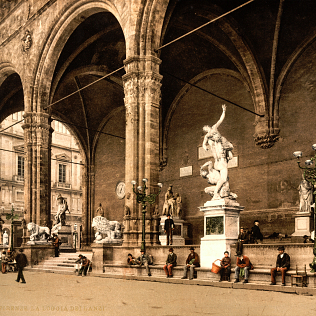The Loggia dei Lanzi, or Loggia della Signoria

In the Piazza della Signoria, adjoining the Uffizi Palace, there is a masterpiece of Medieval architecture: the Loggia della Signoria, built in about 1380, to host public ceremonies and assemblies, during the republican period.
It is called Loggia dei Lanzi, because it is said that landsknechts (lanzichenecchi or lanzi in Italian) encamped here in 1527, while they were going to Rome. According to another version, landsknechts – who were German mercenary soldiers – formed the guard of the Duke Alessandro de’ Medici and they stayed in the loggia to occupy an important and symbolic place for the republic, that was dead.
The Loggia is also called “dell’Orcagna”, because it was once thought that Andrea di Cione, called the Orcagna, built it: actually his brother Benci with Simone Talenti made it. Maybe Orcagna worked on the project of the building.
Built during the 14th century, the loggia is a Gothic style building, but its three big rounded arches paved the way to the great Renaissance architecture: it seems that Brunelleschi took inspiration for his Spedale degli Innocenti from it. During the 16th century, the Loggia lose its original function and became an open air museum.
It hosts some ancient Roman sculptures and some masterpieces from the 16th century: the Perseus with the Head of Medusa by Benvenuto Cellini, the Rape of the Sabine Women and the Hercules and Nessus by Giambologna, and from the 19th century, like the Rape of Polyxena by Pio Fedi.
In 1850 the Minister of the Education put a thermometer and a barometer in the Loggia, to explain to the community the scientific measuring: by this way the open air museum retook his public function. Some years before, in Munich, the Feldherrnhalle was built on the model of the Loggia dei Lanzi.
Now the Loggia is one the most beautiful and characteristic elements in Piazza della Signoria. The terrace built on it is part of the Uffizi itinerary: can you imagine what kind of panorama you can admire from there?











